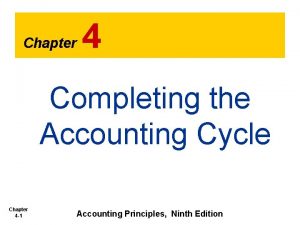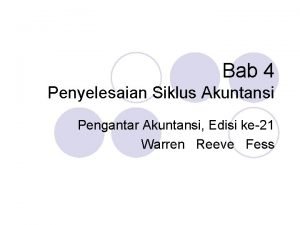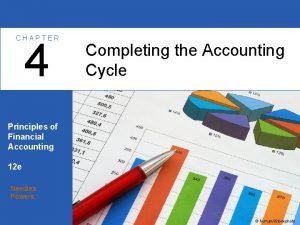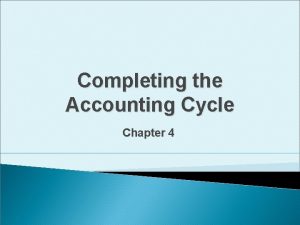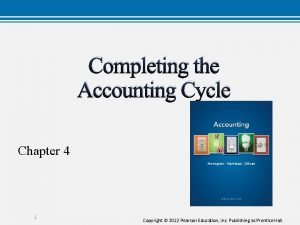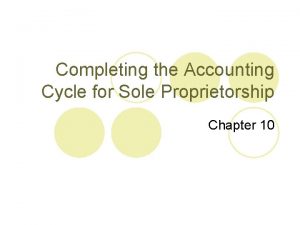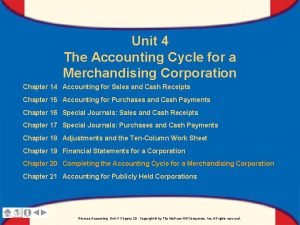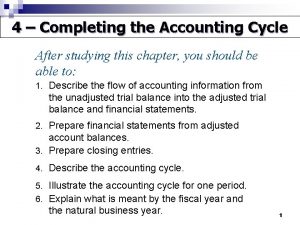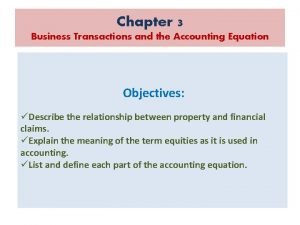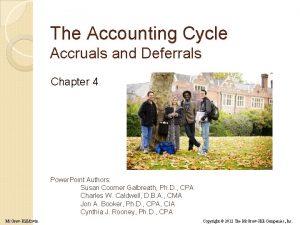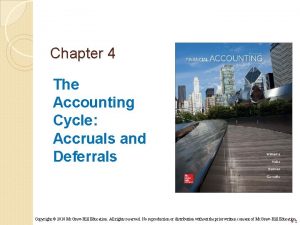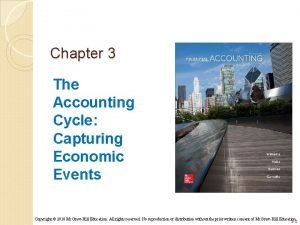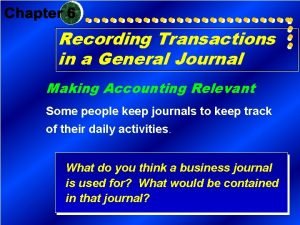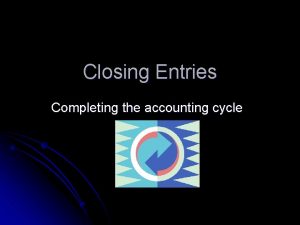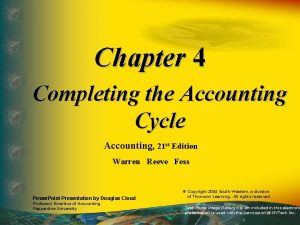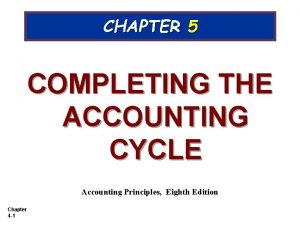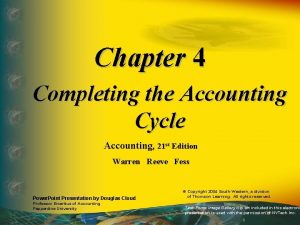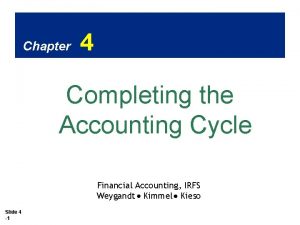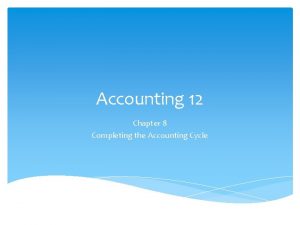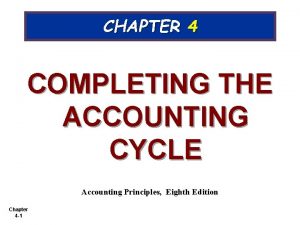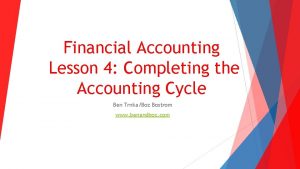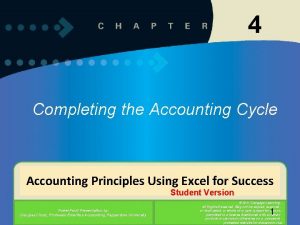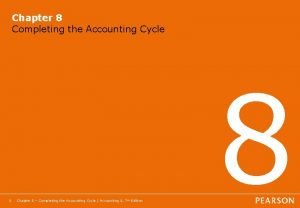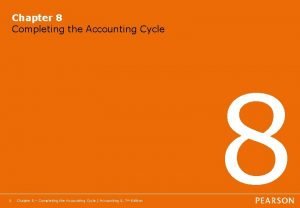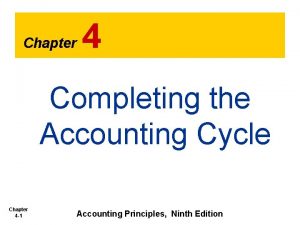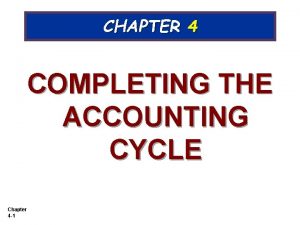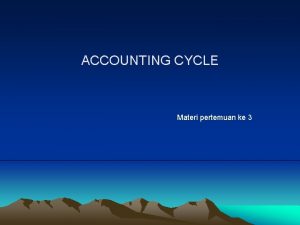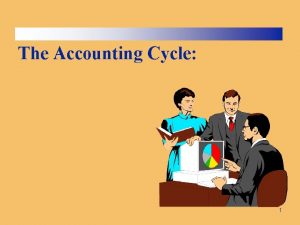Chapter 8 Completing the Accounting Cycle 1 Chapter































































- Slides: 63

Chapter 8 Completing the Accounting Cycle 1 Chapter 8 – Completing the Accounting Cycle | Accounting 1, 7 th Edition 8

Principles of Accounting Adjusting Entries 1. Supplies 2. Prepaid Expenses (Insurance) 3. Late-Arriving Purchase Invoices 4. Unearned Revenue

Adjustments are necessary for items that have been accrued. Accrual Accounting: The attempt to record revenues and expenses , regardless of whether cash is received or not.

How often do we make adjustments? It can be inefficient and costly to account for certain types of transactions on a daily basis.

Adjusting Entries are necessary when accrual basis accounting is used. Adjusting entries allow businesses to adhere to the.

Accrual Basis Accounting Under accrual basis accounting, revenues are recognized when earned (regardless of whether cash has been received) and expenses are recognized when incurred (regardless of cash payment).

The Matching Principle The matching principle states that expenses should be recognized and recorded when those expenses can be matched with the revenues those expenses helped to generate. In other words, expenses shouldn’t be recorded when they are paid. Expenses should be recorded as the corresponding revenues are recorded. This matches the revenues and expenses in a period.

Characteristics of Adjustments Adjusting entries will always have the following characteristics: • Adjusting entries are —no new source document exists for the adjustment. • Adjusting entries are transactions —the Cash account will never be used in an adjusting entry. • Adjusting entries will always involve at least one income statement account and one balance sheet account.

Supplies: You have the following data about an adjustment: On September 1 you purchased supplies for $15000. At the end of the year you do an inventory count and find that you only have $3000 worth of supplies left.

Supplies: Original Entry: On Sept 1 the following entry would be recorded when the supplies were paid: Supplies are an asset account – it is an amount owned by the company that has economic value.

Supplies: Adjusting Entry: On Dec 31 the following entry would be recorded to make an adjustment: Supplies – Balance Sheet Account (Asset) Supplies Expense – Income Statement Account (Expense)

Prepaid Expenses (Insurance): You have the following data about an adjustment: Prepaid $15, 000 for 12 months of insurance on Sept 1 of the current year. Make the appropriate adjustment as of the end of the fiscal period.

Prepaid Expenses: Original Entry: On Sept 1 the following entry would be recorded when the insurance was prepaid: Prepaid Insurance is an asset account – it is an amount owned by the company that has economic value.

Prepaid Expenses (Insurance): Each month, a portion of the prepaid insurance expires. At the end of the fiscal period, the Prepaid Insurance and Insurance Expense accounts must be updated for the insurance that has expired (been used).

Prepaid Expenses (Insurance): Let’s divide the analysis of this transaction into two parts: 1. What accounts are involved? When something is “used up” it indicates an expense account. In this case, we need to debit Insurance Expense for the expired insurance. Furthermore, the asset, Prepaid Insurance, has decreased so we will credit this asset. 2. What is the amount of the adjustment? See the next slide for the calculation of the amount of expired insurance.

Analyzing an Adjusting Entry: An Example $15, 000 for 12 months= $1, 250/month (15, 000/12) ------Policy purchased on Sept 1. Months that have expired between purchase and fiscal year-end = 4 (Sept, Oct, Nov, Dec) Amount of adjustment = $5, 000 ($1, 250/month X 4 months)

Record the Adjustment Adjusting entries are always recorded on the last day of the fiscal period. For our example, the fiscal period closes on Dec 31. The adjustment is journalized as follows: DATE Dec ACCOUNT 31 Insurance Expense Prepaid Insurance POST REF DEBIT CREDIT 5000 00

Late Arriving Purchase Invoices: Simply record the debits and credits in their proper year! For example on December 31: Telephone Expense Accounts Payable 212

Unearned Revenue Let’s try another example. You have the following data about an adjustment: You received $12, 000 advance cash on November 1 for a painting job you are to complete over the next three months.

Unearned Revenue Original Entry: On November 1, Cash would be debited and a liability account called Unearned Painting Revenue would be credited. The liability account is credited because you owe the customer. You owe the customer painting services. )

Analyzing an Adjusting Entry: Each month as you perform painting services, you are earning a portion of the unearned revenue. At the end of the fiscal period, the Unearned Painting Revenue and Painting Revenue accounts must be updated for the revenue that has now been earned.

Completing the Adjustment We have performed step 1 of the analysis: the accounts involved are Unearned Painting Revenue (a liability) and Painting Revenue (a revenue). So far, the adjusting entry looks as follows: DATE Dec ACCOUNT 31 POST REF DEBIT CREDIT Unearned Painting Revenue Note that as we perform the services owed, the liability decreases (this is accomplished by debiting Unearned Painting Revenue) and the revenue earned increases (this is accomplished by crediting Painting Revenue).

Step 2: What amount is Used in the Adjustment? $12, 000 for 3 months= $4, 000/month (12, 000/3) ------Cash advance received on November 1. Two months of work have been completed by the fiscal year-end (Nov and Dec) Amount of adjustment = $8, 000 ($4, 000/month X 2 months)

Complete the Adjusting Entry Now fill in the amount of the adjustment: DATE Dec ACCOUNT 31 Unearned Painting Revenue POST REF DEBIT CREDIT 8, 000 00

Chapter 8 The Work Sheet and Financial Statements 25 Created by D. Gilroy Heart Lake Secondary School

2 6 Purpose of the Work Sheet A work sheet is an used to organize and plan the information for the financial statements. This is a great application for a computerized spreadsheet program.

2 7 Control Accounts for Accounts Receivable and Accounts Payable In the future, when we prepare a trial balance, or a work sheet, we will not display the debtors’ names or creditors’ names associated with Accounts Receivable and Accounts Payable. Alternatively, we will use control accounts The Accounts Receivable control account represents the sum of the balances of all the individual Accounts Receivable accounts.

2 8 Control Accounts for Accounts Receivable and Accounts Payable The Accounts Payable control account represents the sum of the balances of all the individual Accounts Payable accounts. Having two control accounts, instead of dozens or hundreds of individual debtors’ and creditors’ accounts, streamlines the work sheet. The details about the accounts of individual debtors and creditors are kept in separate records. This will be covered in more detail in Chapter 11.

2 9 Steps in Preparing a Work Sheet Step 1 Write in the title of the work sheet and all of the headings: Accounts Trial Balance Income Statement Balance Sheet

3 0 Steps in Preparing a Work Sheet Step 2 Enter all accounts, with their balances, in the first two columns.

3 1 Steps in Preparing a Work Sheet Assets, Liabilities, Capital and Drawings in the Balance Sheet columns. Revenue and Expenses in the Income Statement columns. Step 3 Extend each of the amounts from the trial balance.

3 2 Steps in Preparing a Work Sheet Step 4: ”Balance” the work sheet … (a) take totals

3 3 Steps in Preparing a Work Sheet If the work Make sure the sheet does difference for not balance the Income errors must be found before Statement proceeding to columns equals the preparation the difference of financial for the Balance statements. Sheet columns. Step 4: (b) calc. difference

3 4 Steps in Preparing a Work Sheet Step 4: (c) Record the balancing figure (difference) in the appropriate Income Statement and Balance Sheet columns. Because revenues (Income Statement credits) are greater than expenses (debits) the difference is Net Income and it is recorded in the debit column. The balancing figure appears on the credit side of the Balance Sheet section, because Net Income represents an increase in capital.

3 5 Steps in Preparing a Work Sheet Income Statement Columns Balance Sheet Columns Revenue (credits) greater Net Income (the balancing figure) is on the credit side than expenses (debits). as it is an increase to capital Result … Net Income

3 6 Steps in Preparing a Work Sheet Income Statement Columns Balance Sheet Columns If the work sheet showed a Net Loss, Loss the expenses (debits) Net Loss, the balancing figure would be greater than the revenues (credits). be on the debit side as it is a The Net Loss (balancing figure) decrease to capital. would be in the credit column.

Closing Entries

38 Closing Entries Concepts The Time Period Concept states that financial reporting, or net income in particular, is done in equal periods of time. After you do your adjusting entries and prepare your formal income statements, the accounts must be made ready for the next accounting cycle.

39 Closing Entries Concepts Determine which accounts have balances that continue from one period to the next and which do not. There are two types of accounts … All asset and liability accounts, as well as the owner’s capital account, are considered to be real accounts

40 Closing Entries Concepts have balances that continue into the next fiscal period. (revenue, expense and drawings accounts) have balances that do not continue into the next fiscal period. , with the exception of drawings, are related to the income statement.

41 Closing Entries Concepts A special nominal account, called the Income Summary account, account is used only during the closing entry process. Once the income statement for a period has been completed, the balances in the nominal accounts are no longer useful … their balance must be taken to zero in preparation for the next accounting cycle.

42 Closing Entries Concepts Closing an account means to cause it to have no balance. Any changes in equity during the period are contained in the Revenue, Expense, and Drawings accounts. Closing these nominal accounts moves the values collected in these accounts into the one real equity account, the Capital account.

Complete Accounting Cycle Performed Transactions occur. Accounting entries daily Source documents. recorded in the journal. Performed Ledger balanced by Journal entries posted monthly means of a trial balance. to the ledger accounts. Performed by accounting clerks Work sheet prepared. Performed by accountants Formal income stmt. & balance sheet prepared. Performed at end of Closing entries Adjusting entries each fiscal journalized & posted. period Post-closing trial balance.

Journalizing and Posting the Closing Entries

Summary of Closing Entries

Post-Closing Trial Balance

47 Take a look at figure 8. 10 on page 290!

Adjusting for Depreciation

49 Adjusting for Depreciation Assets that are used to produce revenue over several fiscal periods are known as. Fixed assets are also known as “long-lived assets”, “capital equipment”, and “plant and equipment”. Except for land, all fixed assets will be used up in the course of time and activity.

50 Adjusting for Depreciation Fixed assets decrease or depreciate in value. refers to an allowance made for the decrease in value of an asset over time. It is not possible to calculate depreciation until the end of the asset’s life … only then, can you say how many years it was used and determine its final worth.

51 Adjusting for Depreciation The matching principle dictates that depreciation must be included on every year-end income statement. To do this, accountants must estimate depreciation while the asset is still in use. The two most common methods of calculating depreciation are the:

52 Straight-Line Depreciation The simplest way to estimate depreciation. The Straight-Line method of depreciation divides the net cost of the asset equally over the years of the asset’s life. Original Estimated Cost of Salvage Straight-Line Asset Value Depreciation = Estimated Number of for one year Periods in the Life of the Asset

53 Straight-Line Depreciation You purchased a truck for $78, 000 on January 1, 2007. It is estimated that the truck will be used for six years, and at the end of that time, could be sold for $7, 800. What is the annual depreciation? Straight-Line Depreciation for one year = Estimated Original Cost of - Salvage Value Asset Estimated Number of Periods in the Life of the Asset $78, 000 = =$11, 700 6 $7, 800

54 Straight-Line Depreciation You purchased furniture for $5, 120 on January 1, 2007. It is estimated that the furniture will be used for 10 years, and at the end of that time, could be sold for $500. What is the annual depreciation? Original Cost of Asset Estimated Salvage Value Straight-Line Depreciation = Estimated Number of Periods for one year in the Life of the Asset = = $5, 120 $462 10 $500

Adjusting Depreciation When adjusting for depreciation you would expect to DR Depreciation Expense CR Asset Better: In order to show the value of the Asset at cost, you would not CR Asset for the depreciation rather you 55 Accumulated Depreciation is a ! Its is a permanent account and is not closed at the end of the year.

56 Financial Statement Presentation Income Statement Depreciation expense is shown on the income statement. Each depreciation expense item is shown separately (e. g. Depreciation Expense – Truck). Balance Sheet Accumulated depreciation is deducted from its respective fixed asset account on the balance sheet. Each asset, with its related accumulated depreciation, is shown separately. For example: Truck Less: Accumulated Depreciation $78, 000 11, 700 $66, 300

57 Depreciation for Part Year Sometimes an asset is used for only part of a year. For example, you purchase a building on May 1, 2007 for $120, 000. The building is expected to be used for 30 years, after which it will be worth $30, 000. Your company issued financial statements quarterly (i. e. every 3 months). Annual depreciation = (120, 000 – 30, 000) / 30 = $3, 000 Monthly depreciation = 3, 000 / 12 = $250 per month The depreciation expense would be: 1 st quarter $ 0 and 2 nd quarter $500 (May and June)

58 Declining-Balance Depreciation The declining-balance method is an alternative to the straight-line method of calculating depreciation. The declining-balance method is common because the government of Canada requires a variation of this method for income tax purposes. This method calculates the annual depreciation by multiplying the remaining undepreciated cost (i. e. net book value) by a fixed percentage.

59 Declining-Balance Depreciation Example: You purchase computers on January 1, 2006 for $22, 000. The rate, per the previous slide, is 30%. Depreciation expense would be calculated as follows: 2006: Original Cost $22, 000 Less: Depreciation ($22, 000 x 30%) = 6, 600 Undepreciated cost (net book value) $15, 400 2007: Undepreciated Cost $15, 400 Less: Depreciation ($15, 400 x 30%) = 4, 620 Undepreciated cost (net book value) $10, 780

60 Comparison of the Two Methods of Depreciation For straight-line, assume the computers have an 8 year life with an ending value of $2, 000. The straight-line method produces depreciation figures that are the same each year. The net book value (NBV) or undepreciated cost gradually reduces until it reaches the estimated Salvage value. $22, 000 - $2, 000 8 = $2, 500 / year

61 Comparison of the Two Methods of Depreciation The declining- balance method produces depreciation figures that are larger in the early years and smaller in the later years. The estimated final value is ignored using this method.

62 Tax Regulations Canada Revenue Agency (CRA) requires businesses to use the declining-balance method when calculating depreciation for tax purposes. In addition, the CRA generally only allows 50% of the asset’s cost to be eligible for depreciation in its first year of use regardless of the month it was purchased. The CRA refers to this as the “ 50% Rule”

63 Tax Regulations How would the “ 50% Rule” look?
 Completion of the accounting cycle
Completion of the accounting cycle Chapter 4 completing the accounting cycle answers
Chapter 4 completing the accounting cycle answers Chapter 4 completing the accounting cycle
Chapter 4 completing the accounting cycle Chapter 4 completing the accounting cycle
Chapter 4 completing the accounting cycle Completing the accounting cycle chapter 4
Completing the accounting cycle chapter 4 Chapter 4 completing the accounting cycle
Chapter 4 completing the accounting cycle Completing the accounting cycle for a sole proprietorship
Completing the accounting cycle for a sole proprietorship Post closing trial balance merchandising
Post closing trial balance merchandising Completion of accounting cycle
Completion of accounting cycle Problem 3-10 describing business transactions answer key
Problem 3-10 describing business transactions answer key Financial accounting chapter 1
Financial accounting chapter 1 Chapter 4 the accounting cycle accruals and deferrals
Chapter 4 the accounting cycle accruals and deferrals Chapter 4 the accounting cycle accruals and deferrals
Chapter 4 the accounting cycle accruals and deferrals Chapter 3 accounting cycle
Chapter 3 accounting cycle Accounting cycle
Accounting cycle Chapter 5 two-cycle and four-cycle engines answers
Chapter 5 two-cycle and four-cycle engines answers Chapter 18:2 writing a cover letter and preparing a resume
Chapter 18:2 writing a cover letter and preparing a resume Chapter 18 preparing for the world of work
Chapter 18 preparing for the world of work Hát kết hợp bộ gõ cơ thể
Hát kết hợp bộ gõ cơ thể Bổ thể
Bổ thể Tỉ lệ cơ thể trẻ em
Tỉ lệ cơ thể trẻ em Voi kéo gỗ như thế nào
Voi kéo gỗ như thế nào Thang điểm glasgow
Thang điểm glasgow Hát lên người ơi alleluia
Hát lên người ơi alleluia Các môn thể thao bắt đầu bằng từ đua
Các môn thể thao bắt đầu bằng từ đua Thế nào là hệ số cao nhất
Thế nào là hệ số cao nhất Các châu lục và đại dương trên thế giới
Các châu lục và đại dương trên thế giới Công của trọng lực
Công của trọng lực Trời xanh đây là của chúng ta thể thơ
Trời xanh đây là của chúng ta thể thơ Mật thư tọa độ 5x5
Mật thư tọa độ 5x5 Làm thế nào để 102-1=99
Làm thế nào để 102-1=99 Phản ứng thế ankan
Phản ứng thế ankan Các châu lục và đại dương trên thế giới
Các châu lục và đại dương trên thế giới Thơ thất ngôn tứ tuyệt đường luật
Thơ thất ngôn tứ tuyệt đường luật Quá trình desamine hóa có thể tạo ra
Quá trình desamine hóa có thể tạo ra Một số thể thơ truyền thống
Một số thể thơ truyền thống Bàn tay mà dây bẩn
Bàn tay mà dây bẩn Vẽ hình chiếu vuông góc của vật thể sau
Vẽ hình chiếu vuông góc của vật thể sau Biện pháp chống mỏi cơ
Biện pháp chống mỏi cơ đặc điểm cơ thể của người tối cổ
đặc điểm cơ thể của người tối cổ Giọng cùng tên là
Giọng cùng tên là Vẽ hình chiếu đứng bằng cạnh của vật thể
Vẽ hình chiếu đứng bằng cạnh của vật thể Tia chieu sa te
Tia chieu sa te Thẻ vin
Thẻ vin đại từ thay thế
đại từ thay thế điện thế nghỉ
điện thế nghỉ Tư thế ngồi viết
Tư thế ngồi viết Diễn thế sinh thái là
Diễn thế sinh thái là Các loại đột biến cấu trúc nhiễm sắc thể
Các loại đột biến cấu trúc nhiễm sắc thể Số nguyên tố là số gì
Số nguyên tố là số gì Tư thế ngồi viết
Tư thế ngồi viết Lời thề hippocrates
Lời thề hippocrates Thiếu nhi thế giới liên hoan
Thiếu nhi thế giới liên hoan ưu thế lai là gì
ưu thế lai là gì Sự nuôi và dạy con của hổ
Sự nuôi và dạy con của hổ Khi nào hổ mẹ dạy hổ con săn mồi
Khi nào hổ mẹ dạy hổ con săn mồi Sơ đồ cơ thể người
Sơ đồ cơ thể người Từ ngữ thể hiện lòng nhân hậu
Từ ngữ thể hiện lòng nhân hậu Thế nào là mạng điện lắp đặt kiểu nổi
Thế nào là mạng điện lắp đặt kiểu nổi What are the features of computerized accounting software *
What are the features of computerized accounting software * What is accountin
What is accountin Responsibility centers in management accounting
Responsibility centers in management accounting What is the third step in the accounting cycle?
What is the third step in the accounting cycle?

